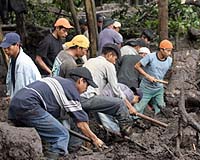| . |  |
. |
Taipei (AFP) Nov 25, 2009 The death and destruction wreaked on Taiwan by Typhoon Morakot was a disaster waiting to happen, aggravated by decades of unrestrained environmental abuse, critics say. Sixty years of intense use of the small island's natural resources left it increasingly fragile and vulnerable to a major blow such as that dealt by Morakot, which left more than 700 people dead or missing in August. Mountainsides collapsed because the deep-rooted trees that should have held them together had been chopped down, while a water-diversion tunnel was blamed for a landslide that buried hundreds of people in one village. "After years of depletion of the land, nature is striking back," said Tsao Chi-hung, magistrate of south Taiwan's Pingtung county, one of the worst affected areas. With 23 million people and the 15th highest population density in the world, Taiwan was bound to encounter problems even with the gentlest of policies. But critics say the typhoon laid bare the consequences of ruthless exploitation of the island, ignored by a government and a people pursuing fast economic development at any cost. "Land development has been excessive," said Liu Yin-yuh, a geography professor at National Taiwan University. The Morakot disaster may be changing the thinking even at the highest levels. President Ma Ying-jeou termed the typhoon, which touched off some of the worst flooding in Taiwan's history, a "painful lesson". The island's government is now introducing a tough new planning law, pending parliament's approval. It is a beginning, critics say, but point out that the law will have to handle the accumulated legacy of practices dating back at least half a century. It began when China's Nationalist government fled to the island at the end of a civil war won by the Communists. The Nationalists brought hundreds of thousands of troops and encouraged many of them to make a living after retirement growing fruit and vegetables in the mountainous areas. The policy was generally seen as a success as it created numerous jobs for idle veterans. But the money they made attracted local farmers to join their ranks, cutting down indigenous trees on the mountains to grow crops such as apples, tea and betel nuts. The cultivated plants have sustained a number of farmers and their dependents for decades, but, it now emerges, at a steep cost to the environment. "The roots of those plants are shallow and unable to protect the soil from the erosion caused by downpours," said Liu of National Taiwan University. The situation grew worse over the past 10 years as hot spring resorts and hotels expanded into the mountains, many built in prohibited areas, despite public criticism. "In some cases, businesspeople have colluded with corrupt government officials," environmental activist Ho Tsung-hsun said. The improper use of land has also hit alarming rates in some coastal areas where fishermen have pumped up underground water to breed fish for export and for local consumers. Pingtung county is one such area, with land sinking by several metres in some cases, explaining why several coastal townships were so hard hit in the flooding triggered by Typhoon Morakot. Fishermen in Pingtung, however, argue that it is hard to find alternative ways of making a living. The same pressure to make ends meet no matter the cost to the environment is faced by betel nut farmers. In Nanhsing, a village in central Taiwan, farmers chopped down a majority of betel nut trees and planted 390,000 deep-rooted trees after a powerful earthquake exposed the dangers posed by an eroding landscape. But in the intervening years some farmers have quietly planted betel nut trees again, said Liu Wei-shih, a local official. "It underscores the problems we face when we encourage the plantation of trees. Farmers can hardly survive by the meagre subsidies they get," he said.
Share This Article With Planet Earth
Related Links Bringing Order To A World Of Disasters When the Earth Quakes A world of storm and tempest
 Rain and Mud Kill 124 In El Salvador As Ida Moves Into Gulf Of Mexico
Rain and Mud Kill 124 In El Salvador As Ida Moves Into Gulf Of MexicoSan Salvador (AFP) Nov 8, 2009 A late-season hurricane ravaged parts of Central America Sunday as floods and landslides killed at least 91 in El Salvador and thousands were left homeless in Nicaragua. Hurricane Ida, which grew to a category two storm Sunday, was moving into the southern Gulf of Mexico but local officials said it had caused no casualties or damage to infrastructure in the popular tourist resort city of Can ... read more |
|
| The content herein, unless otherwise known to be public domain, are Copyright 1995-2009 - SpaceDaily. AFP and UPI Wire Stories are copyright Agence France-Presse and United Press International. ESA Portal Reports are copyright European Space Agency. All NASA sourced material is public domain. Additional copyrights may apply in whole or part to other bona fide parties. Advertising does not imply endorsement,agreement or approval of any opinions, statements or information provided by SpaceDaily on any Web page published or hosted by SpaceDaily. Privacy Statement |